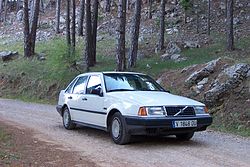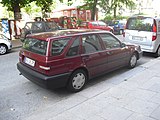Volvo 440
| Volvo | |
|---|---|
|
Volvo 440 (1988-1993)
|
|
| 440 | |
| Production period: | 1988-1996 |
| Class : | Compact class |
| Body versions : | Station wagon |
| Engines: |
Otto engines : 1.6–2.0 liters (57–88 kW) Diesel engine : 1.9 liters (66 kW) |
| Length: | 4345 mm |
| Width: | 1686 mm |
| Height: | 1378 mm |
| Wheelbase : | 2505 mm |
| Empty weight : | 993-1069 kg |
| Previous model | Volvo 340 |
| successor | Volvo S40 / V40 |
The Volvo 440 was the hatchback version of the 400 series (440/ 460 / 480 ), which was manufactured by the summer of 1988 until the end of the 1996th
He was with gasoline and diesel engines from 1.6 to 2.0 liters displacement (57-88 kW / 78-120 hp) available on the Renault -based engines and were also built at Renault, but Porsche -Entwicklungszentrum in Weissach had been tuned differently for Volvo. An anti-lock braking system (ABS) was available as an option. The top model 440 GLT was combined with traction control via ABS .
history
The vehicle in the former was built DAF -Werk Born ( The Netherlands ) from NedCar . In the spring of 1986 the sports coupé 480 (actually Shooting Brake) came onto the market, followed by the 440 hatchback sedan with the same chassis in the summer of 1988. The notchback variant 460 followed in early 1989, but not in all countries. The shape of the types 440 and 460 was changed from accentuated edges in the style of the 700 to larger radii similar to the more rounded 850. For this purpose, among other things, the bonnet and radiator grille, front and rear light units and the bumper panels were changed. The best-selling was the 440 with the 1.8i engine that developed 66 kW (90 hp).
In the autumn of 1993, the 400 series underwent a facelift, so that a few things differ from the first version. These terms are not used by Volvo, because from the revision, Volvo speaks of the Bodyguard model . At the same time, the passive safety of the body was also improved, especially against side collisions. Anti-lock braking system (ABS), driver airbag and automatically height-adjustable front seat belts with mechanical belt tensioners were standard from now on.
From model year 1994 there was a turbo diesel engine with charge air cooler and oxidation catalytic converter with 66 kW (90 hp) in the version for the German market. The engine was manufactured by Renault .
A five-speed mechanical gearbox produced by Renault was standard. For a surcharge for certain engine versions there was a four-stage fully automatic (manufacturer: ZF ) or a stepless fully automatic with push link belt (similar to the system at that time at Fiat).
From 1993, the gasoline engines achieved the Euro 2 standard through recoding. The diesel engine only achieves Euro 1, but can be retrofitted to Euro 2.
The rigid rear axle was developed by Lotus . It is guided by four trailing arms (two pointing downwards forwards and two upwards towards the rear) and a Panhard rod.
The Volvo 440 had an on-board computer that also included an oil level check with a control display when the engine was started ("OK" if the oil level was correct.)
A total of 460,822 Volvo 440s were built.
The 440 was never ex works as a station wagon. However, ASC Detroit from the USA drew up a design sketch, and Heuliez from France even built station wagon prototypes. One of them is in the Volvo Museum today. The Belgian company ATC designed a conversion kit based on the original tailgate of the 440 made of GRP. According to ATC, 200 of these combi-flaps were produced, 150 of which went to the German market, the rest were mainly delivered to the Netherlands. The general importer for Germany was the Bieber company, which was also known for its conversion of the VW Beetle ( Bieber Cabriolet ). The flap was launched in 1994; all ATC station wagons up to autumn 1993 are later retrofits, including the vehicle that has been shown on the TONCAR website for a long time.
ATC and its predecessor company supplied a similar flap for the Renault 25 (was available as an original accessory). This predecessor company was also responsible for building the 480 convertible prototype.
The construction of the ATC station wagon was stopped under pressure from Volvo because Volvo had filed a lawsuit against ATC.
Engines
| Petrol engines | |||||||
|---|---|---|---|---|---|---|---|
| model | Displacement | Maximum power | Max. Torque | Engine code | Mixture preparation | catalyst | Construction period |
| 1.6 | 1596 cc | 61 kW (83 hp) at 5500 min -1 | 125 Nm at 4000 min -1 | B16F109 | injection | Yes | 1993-1996 |
| 1.7 | 1721 cc | 59 kW (80 hp) at 5400 min -1 | 128 Nm at 3300 min -1 | B18K102 | Carburetor | No | 1988-1990 |
| 57 kW (78 hp) at 5400 min -1 | 127 Nm at 3300 min -1 | B18K (D) 102 | Yes | ||||
| 66 kW (90 hp) at 5800 min -1 | 131 Nm at 3600 min -1 | B18KP111 | No | ||||
| 64 kW (87 hp) at 5700 min -1 | 130 Nm at 3600 min -1 | B18KP (D) 111 | Yes | ||||
| 78 kW (106 hp) at 5500 min -1 | 145 Nm at 3900 min -1 | B18EP115 | injection | No | |||
| 75 kW (102 hp) at 5600 min -1 | 142 Nm at 3900 min -1 | B18EP (FP) 115 (/ 230) | Yes | 1988-1996 | |||
| 1.7 turbo | 88 kW (120 hp) at 5500 min -1 | 175 Nm at 3300 min -1 | B18FT (M) 107 | Yes No | |||
| 1.8 | 1794 cc | 66 kW (90 hp) at 6000 min -1 | 140 Nm at 2500 min -1 | B18U10 / 3200/203 | injection | Yes | 1990-1996 |
| 2.0 | 1998 cc | 75 kW (102 hp) at 5500 min -1 | 160 Nm at 2700 min -1 | B20U117 | injection | Yes | 1993-1996 |
| 81 kW (110 hp) at 5500 min -1 | 165 Nm at 3500 min -1 | B20F116 | |||||
| Diesel engines | |||||||
| model | Displacement | Maximum power | Max. Torque | Engine code | Mixture preparation | catalyst | Construction period |
| 1.9 TD | 1870 cc | 66 kW (90 hp) at 4500 min -1 | 180 Nm at 2250 min -1 | D19T204 | Swirl chamber injection | Yes | 1993-1996 |
Web links
- volvocars.com, The Volvo 440 , available April 27, 2019 .
- de.motor1.com of April 26, 2019, Forgotten Studies: Volvo 440/460 station wagon , with pictures; accessed on April 27, 2019.
- motorsport-total.com of July 10, 2018, 30 years of the Volvo 440: When Volvo reached for the stars , accessed on April 27, 2019.
- ntv.de from January 10, 2018, Volvo 440 - legendary Sweden edges , available on April 27, 2019.
Individual evidence
- ↑ http://www.dbk-dimitrov.com/en/dbk-dimitrov-%D1%82%D0%B0%D0%BC%D0%BF%D0%BE%D0%BD-%D0%B7%D0 % B0% D0% B4% D0% B5% D0% BD-% D0% BD% D0% BE% D1% 81% D0% B0% D1% 87-volvo-440-460-480-v-050a Site of a spare parts dealer with drawing of the axis




